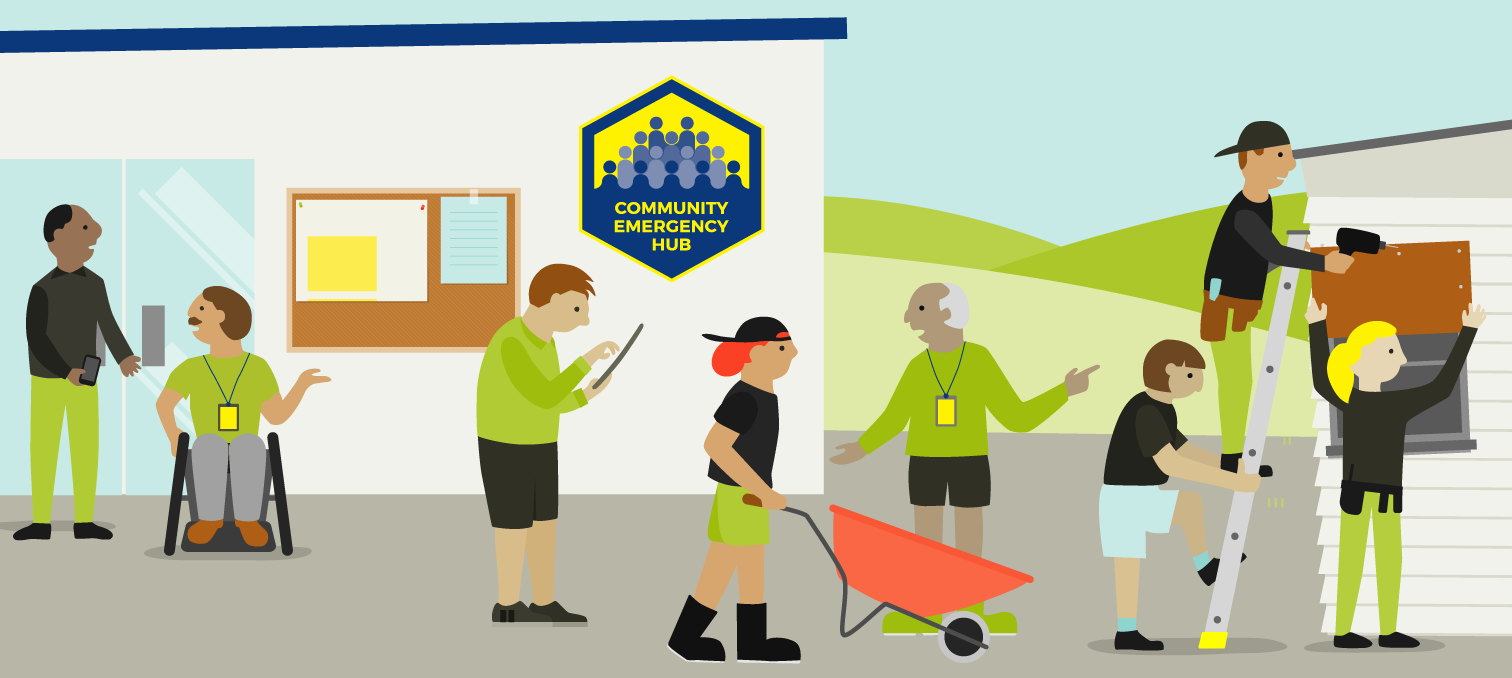
Together, stronger. Being prepared in an emergency starts with you and your community.
Community members in Te Horo talk about being involved with their local Community Emergency Hub
Community Emergency Hub Frequently Asked Questions
Why do we need Community Emergency Hubs?
As we saw in the Canterbury earthquakes and other disasters around the world, the community will naturally come together to support one another after a disaster. Strong, connected communities are better prepared to respond to and recover from disasters.
In a major emergency, official responders will need to prioritise the most urgent issues, so it is likely that for the first few days you will need to help each other within your local community. The Hub is a designated place where you can gather, connect with one another and solve problems using the skills and resources which already exist among your community.
When is a Community Emergency Hub needed?
A Community Emergency Hub is needed when there has been a major emergency where people need assistance, and the support needed is beyond the current capability of council and emergency services.
If official support is available from the council and emergency services, then you probably don't need to open a Hub.
What help and supplies are available at a Community Emergency Hub?
There is no official assistance at the Hub.
Each Hub has a guide for how to coordinate the sharing of information, skills and resources in the community, and some basic equipment to get people started.
There are no supplies, food, water or blankets stored at Hubs. Our communities are full of beds with blankets on them, and pantries with food in them. You can gather the things you need at the time by asking the local community.
What's the role of WREMO and my council?
WREMO leads and coordinates emergency management on behalf of the nine councils in the Wellington Region. Our role is to work with communities to plan for emergencies and practise how to organise an emergency response. Get involved by attending an event near you.
How do Hubs fit into the official emergency response?
Each Community Emergency Hub has a two-way VHF radio in case phones and internet aren't working. The radio will allow the Hub to communicate with the Emergency Operations Centre (EOC) for your council area. At the Hub, you can use the radio to communicate about larger issues that your community hasn't been able to solve locally.
Who has access to open a Community Emergency Hub?
Hubs are often located at community centres or schools, and anyone who has keys can open the doors for the community to use the Hub. This might be staff who live nearby, people who hire the facility regularly, or neighbours who have the keys. If you have the keys, then you can open a Hub when it's needed.
How can I access my Hub if there is no facility map in the guide?
The location of each Hub is available here. To ensure access in an emergency is possible, WREMO works with facility owners to identify a minimum of six keyholders for each Hub who live in the surrounding area and understand their role in opening the facility after a major event.
Currently, not all Hub guides contain facility maps - WREMO is working with facility owners to create these maps for as close to 100% of Hubs before the end of June 2019. All keyholders have knowledge of the facilities and are aware of the location of Hub resources, so a map of each facility is desirable rather than essential.
Following discussion with facility owners, and contrary to what the current guides indicate, the facility maps will not show the location of the Hub lockboxes for security reasons.
We carry out regular training exercises at the Hubs so that community members can familiarise themselves with the layout of the facility and where the Hub kit is stored. If you would like to know more sign up to attend an event in your area.
How is a Community Emergency Hub run and who is in charge?
Each Hub has a guide with descriptions and lanyards for the roles needed to coordinate an emergency response. These roles are supervisor, communications, information coordination, public information, reception, needs and offers, community space and facilities maintenance. Roles are allocated by agreement between whoever turns up. Anyone can be part of the Hub team on the day.
Can people from a Community Emergency Hub take the things they need from others?
No. Everything is through consensus, co-operation, and community generosity. People running the Hub cannot force anyone to provide or do anything that they do not want to do.
What do I do if my Community Emergency Hub doesn't open in an emergency?
If the Hub has not opened, communities can try and find a keyholder or find another venue to set up the community support.
If the Hub building is damaged or there is a risk to safety from the surrounding area, then the Community Emergency Hub should not be opened. If this happens, try to find another venue to set up the Hub.
How long does a Community Emergency Hub stay open?
The Hub can stay open for as long as the community needs to be supported. It might have to move if the facility owners need their space back and will probably close overnight if there is no lighting.
What happened to Civil Defence Centres?
The name was giving the impression that there would be official help available, but with 127 locations across the region, this is not the reality. To avoid confusion, we changed the name to Community Emergency Hubs to show that they are opened and run by the community when for some reason official help can't get there. Some of the street signs still say Civil Defence Centres and need to be changed.
How can I learn more about Community Emergency Hubs?
- Find out how you can get involved